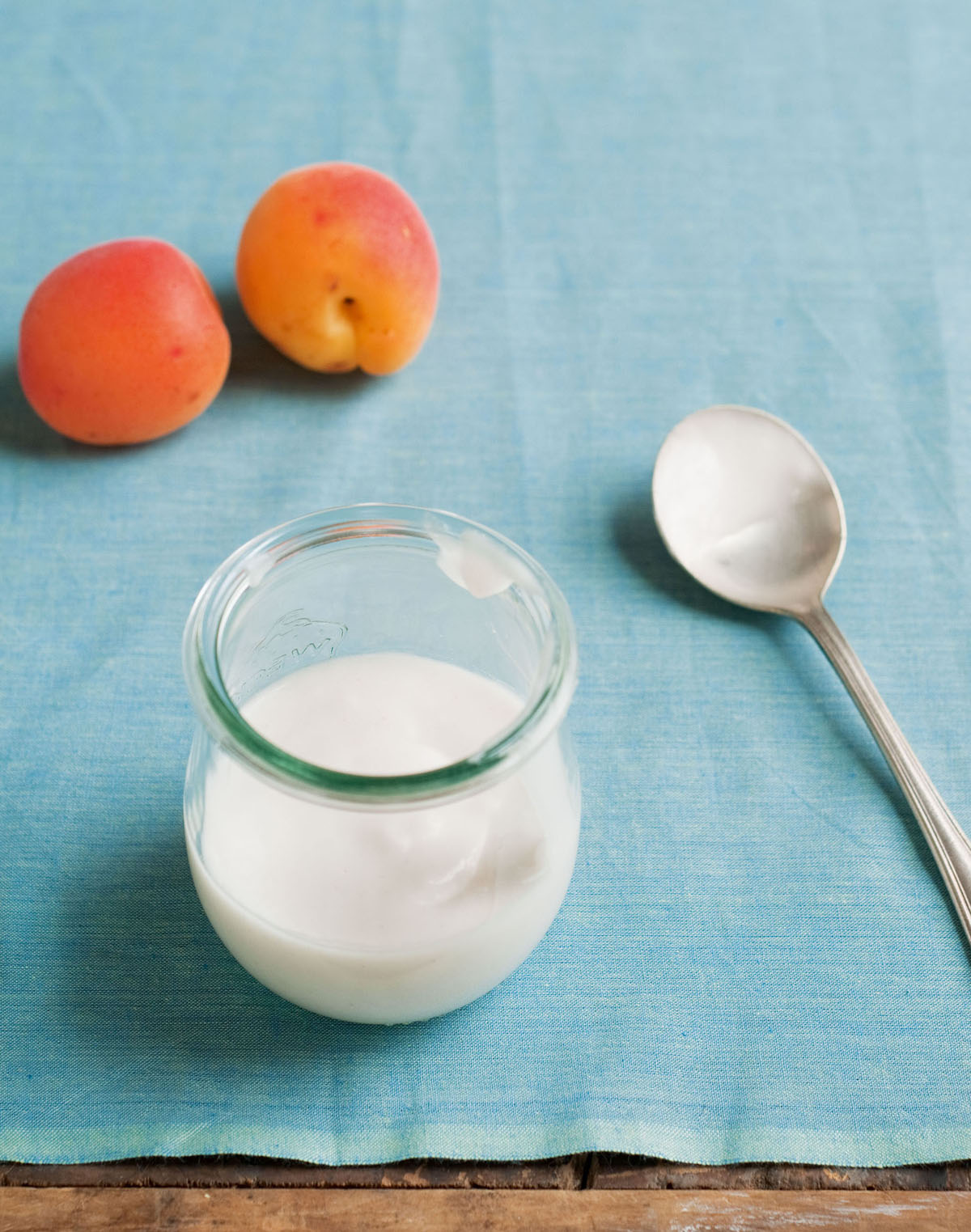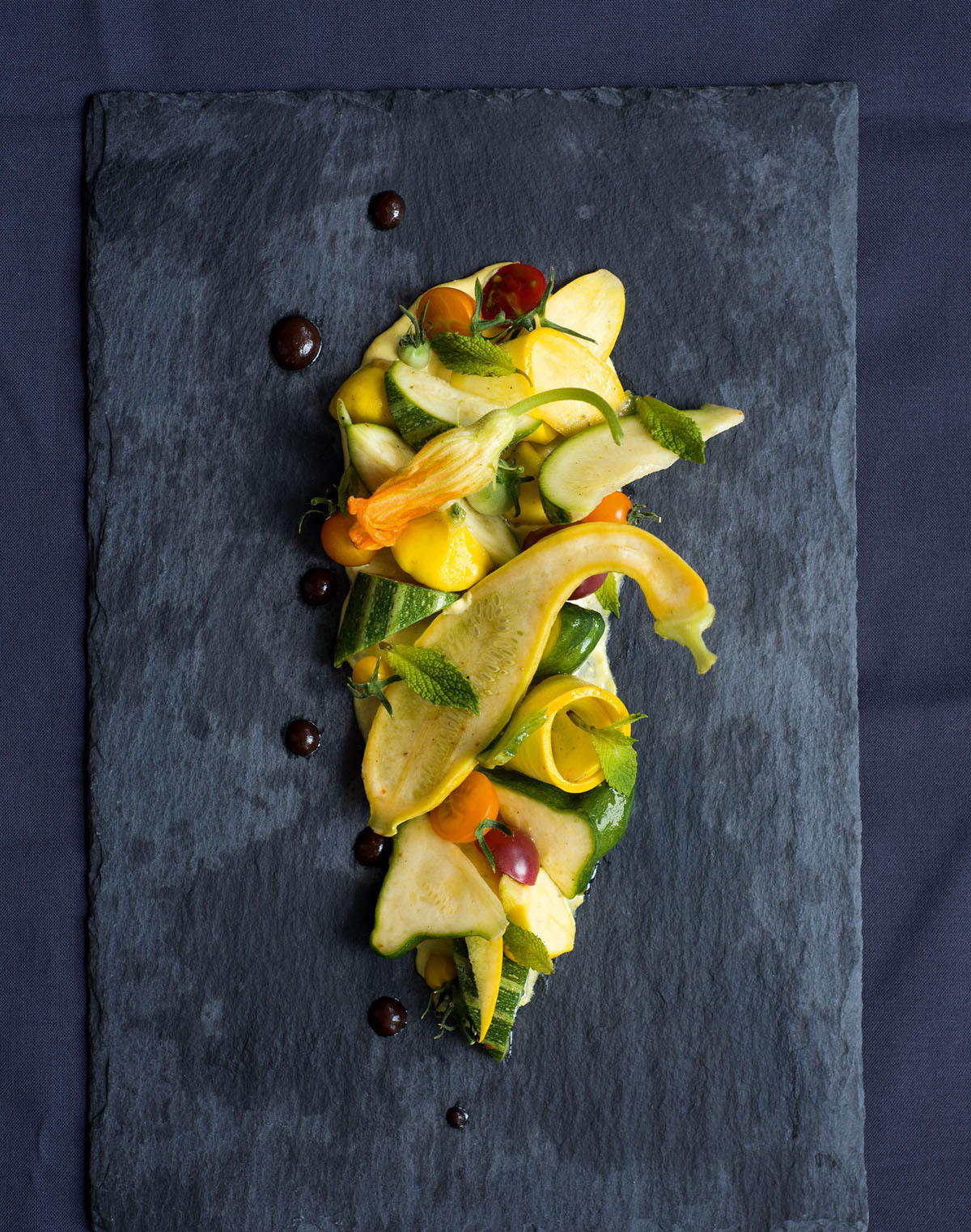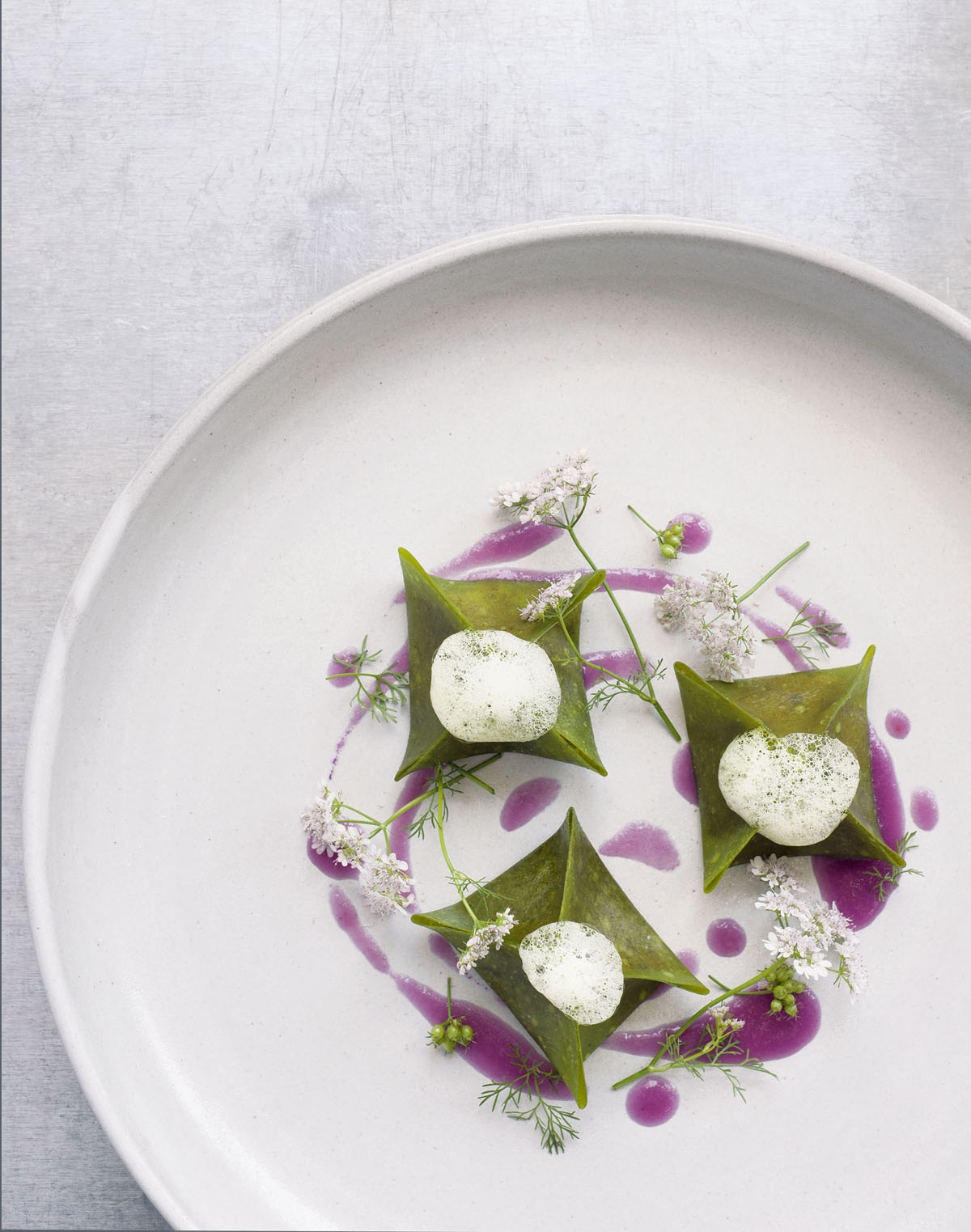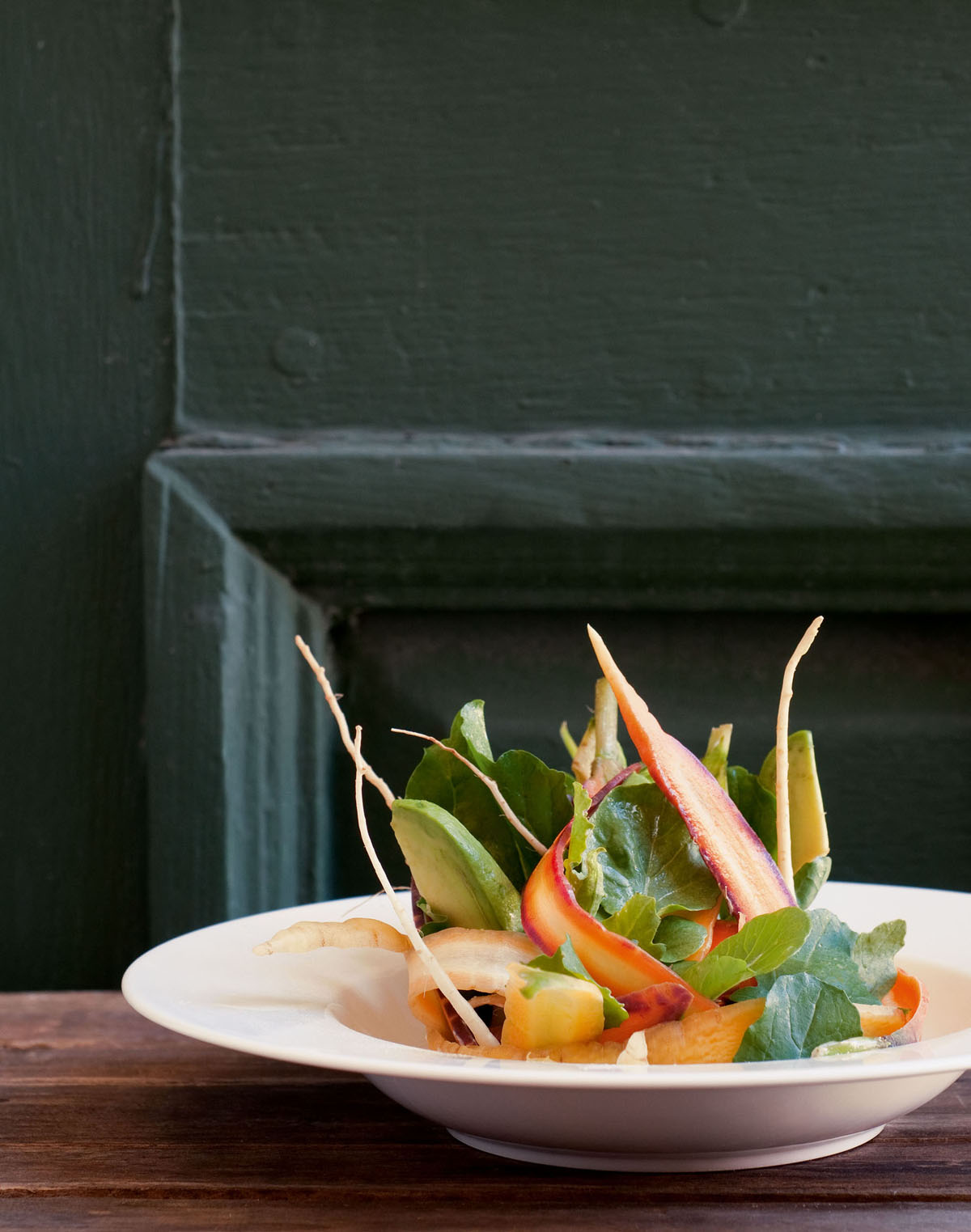Just a few short years ago, we never would have guessed that fermented foods would be so hot. However, the shift in gourmet food, especially in contemporary restaurants such as Noma, in Copenhagen, coupled with more awareness of the benefits in healthy bacteria, has rapidly increased their use. Ferments are now one of the most exciting categories and one we embrace fully, both for their nutritional benefits and for their depth and uniqueness of flavor. —MK

Summer Squash. Saffron Yogurt. Black Olive.
Serves 4 to 6
This dish is best at the peak of summer. Using a variety of squash makes an excellent salad. —SW
Summer Squash
| 2 medium zucchini |
| 2 medium goldbar squash |
| 4 small pattypan squash |
| 12 sungold or heirloom cherry tomatoes |
| Pinch of sea salt |
Saffron Yogurt
| 2 cups cashews, soaked overnight |
| 1 probiotic capsule |
| 1 tablespoon apple cider vinegar |
| Sea salt, to taste |
| A heavy pinch of saffron |
Black Olive Oil
| 1 cup pitted whole black olives |
| 1/2 cup olive oil |
| 1/2 cup water |
Thyme Oil
| 1 cup fresh thyme leaves |
| 1 teaspoon salt |
| 2 cups olive oil |
Sherry Thyme Dressing
| 1 cup sherry vinegar |
| 1 tablespoon ras el hanout powder |
| 1 teaspoon salt |
| 1/2 teaspoon chile flakes |
| 1 cup Thyme Oil |
| 1 cup olive oil |
Garnish
| 6 zucchini or squash blossoms |
| 1/2 cup fresh mint leaves |
Summer Squash Cut and slice squash into various shapes. Slice tomatoes in half.
Saffron Yogurt Using a high-speed blender, blend cashews and probiotic capsule to a yogurt-like consistency, adding a little water, if needed. Cover and let set for 8 to 12 hours. Place yogurt in blender and add vinegar and salt; blend. Rub saffron threads between fingers as you let it fall into mixture in blender. Stir lightly with a spoon and let bloom in yogurt for 5 minutes. Blend until creamy.
Black Olive Oil Using a high-speed blender, blend all ingredients together. Pass through a strainer.
Thyme Oil Steep thyme and salt in oil, at room temperature, for 12 to 24 hours. Blend all ingredients together and strain through a chinois strainer at least 2 times.
Sherry Thyme Dressing Blend vinegar, ras el hanout, salt, and chile flakes together. With the blender running, slowly pour in oils to emulsify.
Assembly Place squash and tomatoes in a bowl and toss with the dressing and a pinch of sea salt. Put a healthy dollop of Saffron Yogurt off center on each serving plate. Using a small offset spatula, spread the yogurt across the plate making a bed for the salad. Build salads using all different shapes and varieties of the squash and the tomatoes. Drop some dots of Black Olive Oil on the salads using a squeeze bottle. Garnish each plate with a squash blossom and mint leaves.

Pickled Plum. Shiso. Horseradish Crisp.
Serves 6
Japanese chefs are masters at the art of pickling and employing bursts of briny flavor throughout a meal, much in the way a great musician will implement a variety of tones to keep the flow going. This style is definitely tart, yet equalized with sweetness, so the overall effect is powerful while still not overwhelming. —MK
Plums
| 1/4 cup rice vinegar |
| 1 tablespoon agave nectar |
| 1 tablespoon minced ginger |
| 1/4 teaspoon sea salt |
| 6 unripe plums |
Shiso Cream
| 1 cup almonds, soaked overnight |
| 1/2 cup filtered water |
| 1/2 cup fresh shiso leaves |
| 1 tablespoon pickled plum brine |
| 1/2 teaspoon sea salt |
Horseradish Crisps
| 1 cup flax seeds |
| 1 cup peeled and chopped horseradish |
| 1/2 cup water |
| 1 teaspoon salt |
Garnish
| Micro shiso |
Plums Mix vinegar, agave nectar, ginger, and salt in a bowl to make a brine. Slice plums in half and remove the pits. Add plums to brine and toss to combine. Let plums set in brine for at least 2 hours at room temperature. Strain from brine and seal in a vacuum bag at 100 percent. Refrigerate.
Shiso Cream Using a high-speed blender, blend all ingredients until completely smooth, adding more water, if needed, to reach desired consistency. Pass through a strainer to remove any clumps.
Horseradish Crisps Using a high-speed blender, blend all ingredients until thoroughly combined. Spread on a teflex sheet. Dehydrate at 115 degrees for 8 hours or until crisp. Hand break into rough shapes.
Assembly Slice plums into wedges, and place randomly on individual serving plates. Using a squeeze bottle, put Shiso Cream dollops around and close to plums. Place Horseradish Crisps so they are sticking up lying against the plums. Garnish with micro shiso.
Kimchee Dumplings.
Serves 6
While having a vegan tasting menu at the bar of one of Boston’s best restaurants, O-Ya, I was served a kimchee dumpling, made with a fresh, thin dough, rich and garlicky, and full of flavor. I liked it a lot, but I liked the idea of it even more. We set about making our own raw version a few years ago. This has since become one of our signature dishes and likely the most photographed. —MK
Purple Kimchee
| 1 head purple cabbage |
| 4 tablespoons sea salt, divided |
| 1 quart cold water |
| 1 tablespoon minced garlic |
| 1 tablespoon minced ginger |
| 1 teaspoon red chile flakes |
Kimchee Filling
| 1 cup raw cashews, soaked overnight |
| 1/2 tablespoon tamari |
| 1/2 tablespoon sesame oil |
| 1 tablespoon raw tahini |
| 1 teaspoon agave nectar |
| 1/2 cup Purple Kimchee |
Cilantro Wrappers
| 2 cups young coconut meat |
| 1/4 teaspoon sea salt |
| 1/4 cup cilantro-spinach juice* |
Sesame Ginger Foam
| 1/2 cup ginger juice** |
| 1/4 cup sesame oil |
| 1 teaspoon agave nectar |
| 1/2 teaspoon lecithin |
Kimchee Purée
| 1 cup Purple Kimchee |
| 1/2 cup Purple Kimchee brine |
| 1/4 cup olive oil |
Garnish
| Micro cilantro |
| Edible flowers |
Purple Kimchee Day 1: Separate and wash cabbage leaves. Dilute 3 tablespoons of salt in the water. Place cabbage leaves in the water, being sure that the water completely covers all the leaves. Put a plate or other heavy object on top of leaves to ensure that they stay submerged. Refrigerate overnight.
Day 2: Pour off water and thoroughly rinse cabbage leaves. Shake them gently in the sink to remove excess moisture.
Make a paste out of the garlic, ginger, red chile flakes, and remaining salt. Tear cabbage leaves into a large bowl and add paste. Use your hands to rub paste evenly onto all cabbage leaves. Transfer seasoned cabbage leaves into a large glass jar. Be sure to use firm pressure with your hands to push down on the cabbage as it is packed inside the jar. Transfer any liquid that accumulated during the mixing process into the bottle as well.
This liquid will become kimchee brine. Some liquid will also come out of the cabbage leaves as you press down on them as they are stacked in the jar. Leave about 2 inches of room at the top of the jar before capping it tightly with a lid. Allow kimchee to set at room temperature for 2 to 3 days.
Kimchee Filling Process cashews, tamari, oil, tahini, agave nectar, and kimchee in a food processor until a chunky consistency is achieved. If the mixture is wet, press out the excess liquid through a chinois strainer.
Cilantro Wrappers Using a high-speed blender, blend coconut, salt, and juice until very smooth. Spread mixture in a thin, even layer over 2 teflex sheets. Dehydrate for 4 to 5 hours at 115 degrees. Once dry but still pliable, remove from dehydrator and gently peel off teflex sheets. Cut wrappers into 18 (3-1/2-inch) squares. Store on tray with parchment paper between layers, sealing the whole tray tightly with plastic wrap.
Sesame Ginger Foam Combine all ingredients in a blender.
Kimchee Purée Place kimchee and brine in a high-speed blender and blend to combine. Add oil at slow setting to make the purée. Pass through a strainer.
Assembly Using a spoon or squeeze bottle, drizzle individual serving plates with the Kimchee Purée.
Place a tablespoon of the Kimchee Filling in the middle of each Cilantro Wrapper. Bring corners to the middle and press together to make the dumplings. Place 3 dumplings on each plate on top of the purée.
Using an immersion blender, foam up the Sesame Ginger Foam and spoon about a teaspoon on top of each dumpling. Garnish with micro cilantro and some edible flowers.
*Using a electric juicer, juice a handful of spinach and cilantro. The spinach will keep the cilantro from oxidizing. Strain juice.
**Using an electric juicer, juice peeled ginger. Strain juice.

Heirloom Carrot. Cashew Yogurt. Cumin Crisp.
Serves 4
This recipe was one of the first signature dishes at M.A.K.E., and an early example of our new, cleaner style of raw food that we have come to embrace. —MK
Rainbow Carrots
| 12 small rainbow heirloom carrots |
| Pinch of sea salt |
| 1 tablespoon apple cider vinegar |
| 1 tablespoon olive oil |
Cashew Yogurt
| 2 cups cashews, soaked overnight |
| 1 probiotic capsule |
| 1 tablespoon apple cider vinegar |
| 1/2 teaspoon cumin |
| Sea salt, to taste |
Carrot Cumin Crisps
| 2 large carrots |
| 1 tablespoon cumin seeds |
| 1/2 cup water |
| 1 tablespoons agave nectar |
| 1/2 teaspoon salt |
| 1/2 teaspoon berbere spice* |
Garnish
| 1/2 cup carrot tops or flat-leaf parsley leaves |
Rainbow Carrots Slice carrots vertically and very thin using a mandolin. Place in a bowl and add salt, vinegar, and oil. Toss to combine and marinate for a few minutes until carrots are well flavored.
Cashew Yogurt Using a high-speed blender, blend cashews and probiotic capsule to a yogurt-like consistency, adding a little water, if needed. Cover and let set for 8 to 12 hours, or overnight.
Place yogurt in a blender and blend with vinegar, cumin and salt.
Carrot Cumin Crisps Using a high-speed blender, blend all ingredients until smooth. Thinly spread on teflex sheets and dehydrate at 115 degrees for 12 hours or until completely dry. Break apart into rough-shaped crisps.
Assembly Spread about 2 tablespoons Cashew Yogurt on the bottom of shallow bowls for each serving. Place some carrots on top of yogurt, building a tight ball, and add a few Carrot Cumin Crisps. Garnish with carrot leaves or parsley.
*Berbere spice is a spice blend native to Ethiopia. Like curries in India, Ethiopian families often have their own blend of this spice. The blend usually consists of chiles, garlic, ginger, and dried basil.
